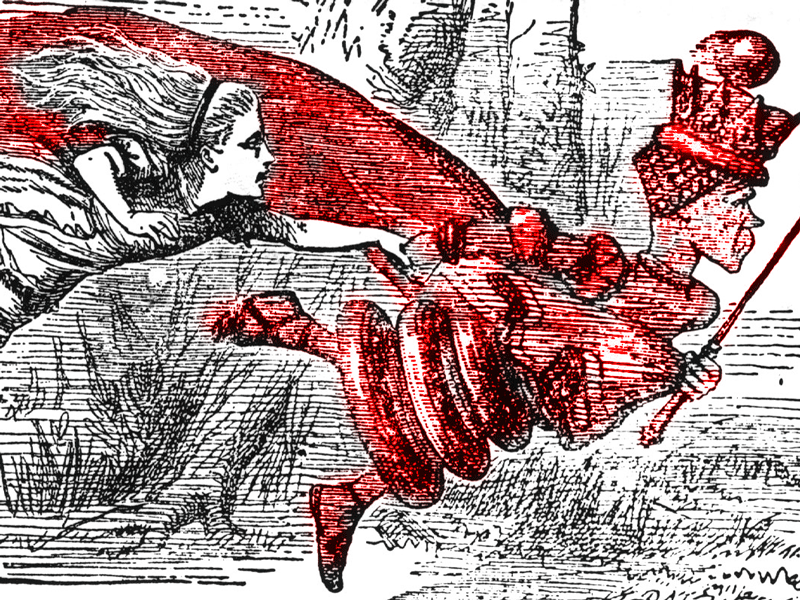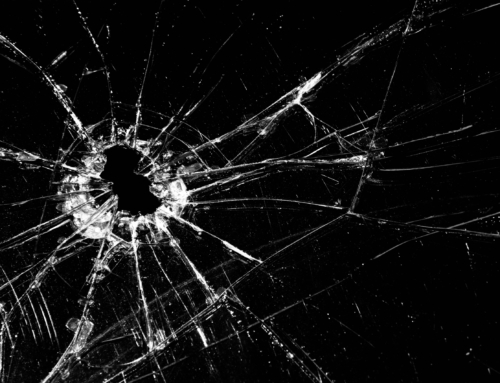Evolutionary biologist Leigh van Valen (1973), used the Red Queen as a metaphor for his evolutionary principle that regardless of how well a species adapts to its current environment, it must keep evolving to keep up with its competitors and enemies who are also evolving. Van Valen’s inspiration for the metaphor came from Lewis Carroll’s Through The Looking Glass (his sequel to Alice in Wonderland). At one point, Alice finds herself running with the Red Queen, faster and faster but staying in the same place.
Alice never could quite make out, in thinking it over afterwards, how it was that they began: all she remembers is, that they were running hand in hand, and the Queen went so fast that it was all she could do to keep up with her: and still the Queen kept crying ‘Faster! Faster!’ but Alice felt she could not go faster, though she had not breath left to say so.
The most curious part of the thing was, that the trees and the other things round them never changed their places at all: however fast they went, they never seemed to pass anything. ‘I wonder if all the things move along with us?’ thought poor puzzled Alice. And the Queen seemed to guess her thoughts, for she cried, ‘Faster! Don’t try to talk!’
And finally…
The Queen propped her up against a tree, and said kindly, ‘You may rest a little now.’
Alice looked round her in great surprise. ‘Why, I do believe we’ve been under this tree the whole time! Everything’s just as it was!’
‘Of course it is,’ said the Queen, ‘what would you have it?’
‘Well, in our country,’ said Alice, still panting a little, ‘you’d generally get to somewhere else — if you ran very fast for a long time, as we’ve been doing.’
‘A slow sort of country!’ said the Queen. ‘Now, here, you see, it takes all the running you can do, to keep in the same place.
If you want to get somewhere else, you must run at least twice as fast as that!’
You can find The Red Queen Effect almost anywhere…
In Nature
An obvious example of this effect are the “arms races” between predators and prey. The only way predators can compensate for a better defense by the prey (e.g. rabbits running faster) is by developing a better offense (e.g. foxes running faster).
Human Conflict
Imagine two competing groups that find themselves in a security dilemma when one group employs defensive measures (which possess inherent offensive capabilities) to improve their security. This launches an arms race where each side expends ever increasing amounts of resources in order to outpace the other and gain advantage. Typically both sides continue to match each other measure for measure. No matter how many resources each side invests, neither is able to gain a lasting advantage.
Business Competition
Most companies try to differentiate themselves from their competitors with better products or better processes for an improved cost structure. The problem is that their competitors are doing the same thing. Therefore, after the introduction of new products or implementation of better processes, the situation is pretty much the same. You moved forward as did your competitor. If you do not move you fall behind.
Consequently, you do nothing and fall behind, or run hard to stay where you are (“…it takes all the running you can do, to keep in the same place.”)? Yes, it’s a dilemma (a situation in which a difficult choice has to be made between two or more alternatives, especially equally undesirable ones). It is useful, at some level, to have a metaphor to “explain” a complex and evolutionary dilemma. For those of us in business that, while interesting, is insufficient.
The Red Queen Prescription
What comes after you understand the dilemma? What do you do? The Red Queen herself provides an answer, “If you want to get somewhere else, you must run at least twice as fast as that!” But weren’t you already doing “all the running you can do”? When you’re doing all you can do how do you do twice as much?
Something has to change. But what change? I don’t know the specifics in your case, but I know this: you have to interrupt your problem solving. The change you’re looking for is an advantage that many seek and few find. It begins with you. Yes, you and how you think. Since you can’t run any faster, stop running long enough to think… differently.
Remember, The Red Queen Effect describes a dilemma. Dilemmas are never really resolved, only managed more or less well. It requires a mind shift to see “one dilemma” instead of “two goals”, but until we make the perceptual shift, it is extremely hard to envision what is required for managing a dilemma.
Since there is no permanent resolution, the process for exploring options and for learning from experience becomes more important than the actual “solution” proposed for the present.
In a race without end, there are no winners, only losers. Your ability to change means survival. It means living to fight another day. And another one after that. That makes change (thinking differently) more than a capability, which it is: it is a competitive advantage if you can do it on demand.






